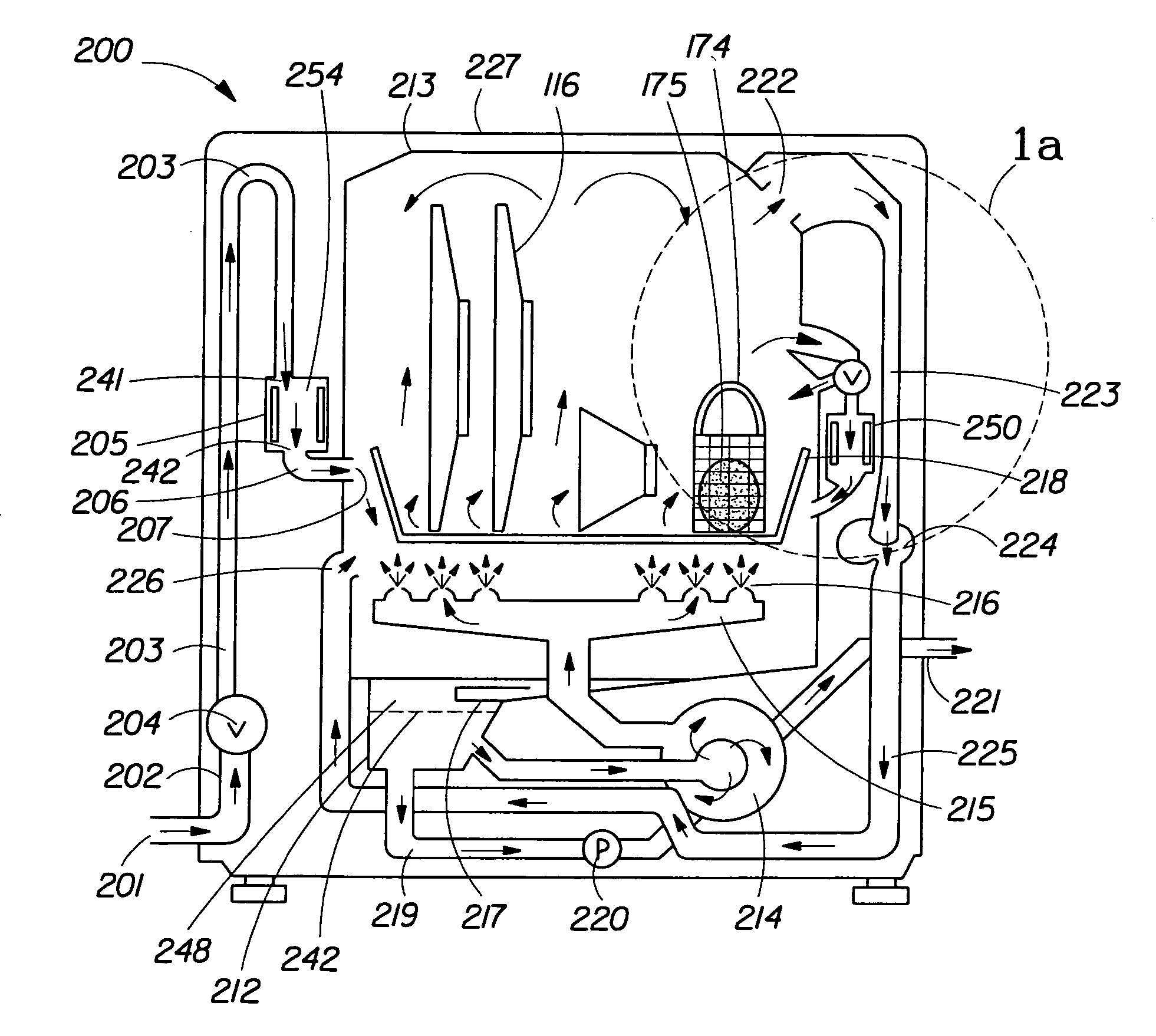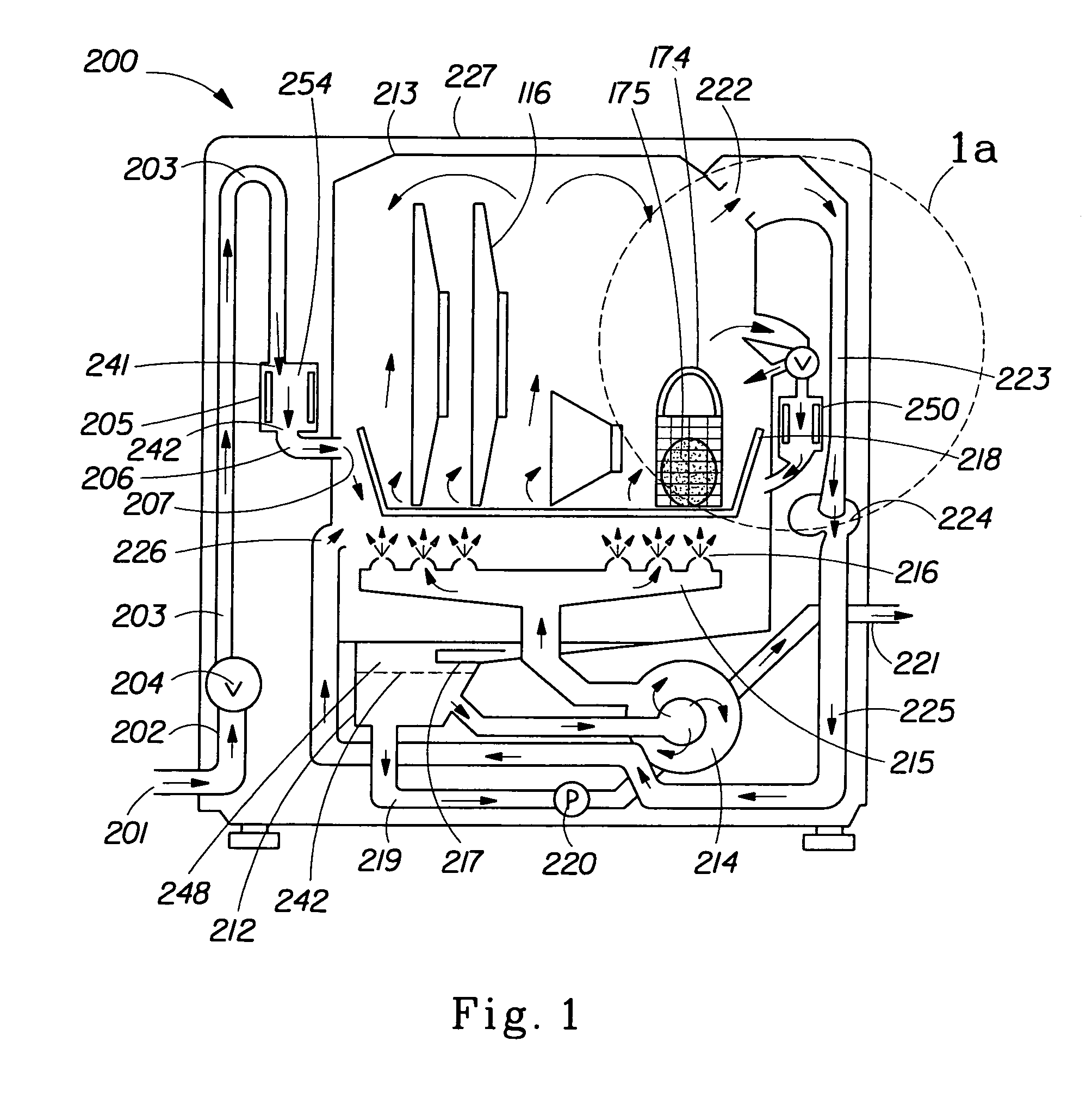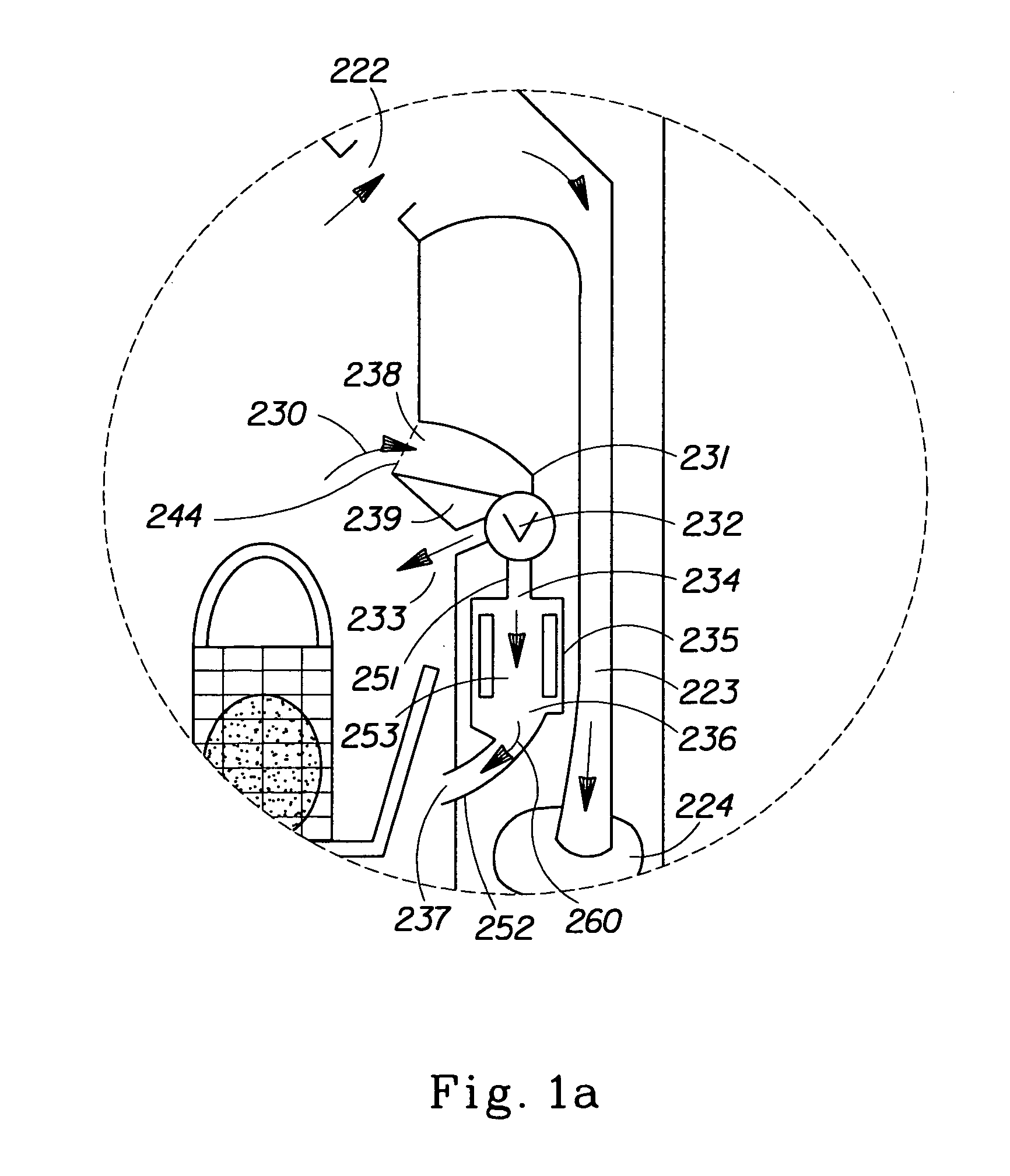[0017] In one aspect of the present invention, a method of improved cleaning, sanitizing, and / or stain removal of tableware in an automatic dishwashing appliance can comprise an attached electrochemical cell for producing electrolyzed water, said method comprising the steps of: (a) placing tableware in need of treatment into said appliance; (b) providing at least one attached, signal-sensing electrochemical cell comprising at least one inlet opening and one outlet opening, and at least one pair of electrodes defining a cell chamber comprising a passage formed therebetween through which said aqueous electrolytic solution can flow, wherein said cell and / or appliance further can comprise a signal sensor that can electrically activate and / or deactivate the production of electrolyzed water in said cell; (c) providing an aqueous electrolytic solution in said appliance in fluid communication with said electrochemical cell; (d) providing at least one activator and / or deactivator; (e) intermittently activating said electrochemical cell via said at least one activator at a specific time or times in the wash and / or rinse cycle; (f) electrolyzing said aqueous electrolytic solution in said electrochemical cell to produce at least some electrolyzed water; (g) discharging said electrolyzed water into the wash and / or rinse liquor via a wash basin of said appliance during at least one specific time in the wash and / or rinse cycle(s); (h) interrupting electrolyzation of said aqueous electrolytic solution and / or not releasing said electrolyzed water at other times in the wash and / or rinse cycle(s); (i) contacting said tableware in need of treatment with said electrolyzed water comprising said wash and / or rinse liquor; (j) intermittently deactivating said electrochemical cell via said deactivator during at least one specific time in the wash and / or rinse cycle(s); (k) optionally contacting said tableware with a wash and / or rinse liquor comprising a chlorine-bleach-scavenging agent or metal-protecting agent; and (1) optionally repeating steps (c) through (k) until said tableware are treated.
[0018] In another aspect of the present invention, a method of improved cleaning, sanitizing, and / or stain removal of tableware in an automatic dishwashing appliance comprising an unattached electrolytic device for producing electrolyzed water, said method comprising the steps of: (a) placing tableware in need of treatment into said appliance; (b) providing an unattached, signal-sensing electrolytic device comprising at least one electrochemical cell comprising at least one inlet opening and one outlet opening, and at least one pair of electrodes defining a cell chamber comprising a passage formed therebetween through which said aqueous electrolytic solution can flow, wherein said appliance, device and / or cell further comprising a signal sensor that can electrically activate and / or deactivate the production of electrolyzed water in said cell; (c) providing an aqueous electrolytic solution in said appliance in fluid communication with said electrochemical cell; (d) providing at least one activator and / or deactivator; (e) intermittently activating said electrolytic device via said at least one activator at a specific time or times in the wash and / or rinse cycle; (f) electrolyzing said aqueous electrolytic solution in said electrochemical cell to produce at least some electrolyzed water; (g) discharging said electrolyzed water into the wash and / or rinse liquor via a wash basin of said appliance during at least one specific time in the wash and / or rinse cycle(s); (h) interrupting electrolyzation of said aqueous electrolytic solution and / or not releasing said electrolyzed water at other times in the wash and / or rinse cycle(s); (i) contacting said tableware in need of treatment with said electrolyzed water comprising said wash and / or rinse liquor; (j) intermittently deactivating said electrolytic device via said deactivator during at least one specific time in the wash and / or rinse cycle(s); (k) optionally contacting said tableware with a wash and / or rinse liquor comprising a chlorine-bleach-scavenging agent or metal-protecting agent; and (k) optionally repeating steps (c) through (k) until said tableware are treated.
[0019] In another aspect of the present invention, a method of improved cleaning, sanitizing, and / or stain removal of tableware in an automatic dishwashing appliance can comprise an electrolytic device, said method using a signal system comprising a signal-providing detergent in conjunction with a signal-sensing device, said method comprising the steps of: (a) placing tableware in need of treatment in said appliance; (b) providing a signal-sensing electrolytic device comprising at least one electrochemical cell at least one inlet opening and one outlet opening, and at least one pair of electrodes defining a cell chamber comprising a passage formed therebetween through which said aqueous electrolytic solution can flow, wherein said appliance, device and / or cell further comprising a signal sensor that can be activated and / or deactivated by a composition comprising at least one signal-providing agent; (c) providing an aqueous electrolytic solution in fluid communication with said electrochemical cell via said electrolytic device; (d) providing at least one activator and / or deactivator in the form of a signal-providing composition comprising at least one signal-providing agent; (e) optionally contacting said signal sensor with said at least one signal-providing composition in order to activate and / or deactivate said at least one electrochemical cell, wherein said activation and / or deactivation starts or stops electrolyzed water production in said signal-sensing electrolytic device; (f) optionally contacting said signal sensor of said signal-sensing electrolytic device with said at least one signal-providing composition in order to activate a timer to delay said electrolyzed water production in said signal-sensing electrochemical cell for a specific time period, wherein after said timed delay said at least one electrochemical cell can be activated; (g) passing said aqueous electrolytic solution through at least one activated electrochemical cell to generate at least some electrolyzed water in the wash and / or rinse liquor of said appliance; (h) contacting said tableware with said at least some electrolyzed water in the wash and / or rinse cycle of said appliance; (i) optionally contacting said signal sensor of said electrolytic device with said composition comprising said at least one signal-providing agent to deactivate said at least one electrochemical cell in order to stop production of said electrolyzed water; (j) optionally contacting said tableware with a wash and / or rinse liquor comprising a chlorine-bleach-scavenging agent or metal-protecting agent; and (k) optionally repeating steps (c) through (j) until the tableware needing treatment are treated.
[0020] In yet another aspect of the present invention, an article of manufacture can comprise (a) a component selected from the group consisting of an electrochemical cell refill and / or replacement cartridge, product refill and / or replacement cartridge, filter, elastomeric slit valve, or combinations thereof, (b) information and / or instructions in association with said article comprising the steps describing the use of an electrolytic device, electrochemical cell, electrolytic solution, detergent and / or rinse aid signal-providing composition comprising at least one signal-providing agent, replaceable component, or combinations thereof, in an automatic dishwashing appliance comprising an electrolytic device for treating tableware for improved cleaning, sanitizing, and / or stain removal; (c) optionally, a component selected from the group consisting of suds suppressor, perfume, a chlorine-bleach-scavenging agent, a metal-protecting agent, and mixtures thereof, and mixtures thereof; and (d) optionally, a component selected from the group consisting of an electrolytic composition comprising chloride ions, an electrolytic composition comprising chlorite ions, an electrolytic composition comprising salts having the formula (M)x(XO2)y and / or (M)x(X)y wherein X can be Cl, Br, or I and wherein M can be a metal ion or cationic entity and wherein x and y are chosen such that the salt can be charge balanced, an electrolysis precursor compound, an electrolysis salt with low water solubility, an electrolysis precursor compound contained within a medium for controlled release, and mixtures thereof, wherein said product optionally housed in a porous basket;
[0021] The following description can be provided to enable any person skilled in the art to make and use the invention, and can be provided in the context of a particular application and its requirements. Various modifications to the embodiments will be readily apparent to those skilled in the art, and the generic principles defined herein can be applied to other embodiments and applications without departing from the spirit and scope of the invention. The present invention can be not intended to be limited to the embodiments shown. Thus, since the following specific embodiments of the present invention are intended only to exemplify, but in no way limit, the operation of the present invention, the present invention can be to be accorded the widest scope consistent with the principles, features and teachings disclosed herein.
[0022] It should be understood that every maximum numerical limitation given throughout this specification will include every lower numerical limitation, as if such lower numerical limitations were expressly written herein. Every minimum numerical limitation given throughout this specification will include every higher numerical limitation, as if such higher numerical limitations were expressly written herein. Every numerical range given throughout this specification will include every narrower numerical range that falls within such broader numerical range, as if such narrower numerical ranges were all expressly written herein.
 Login to View More
Login to View More 


